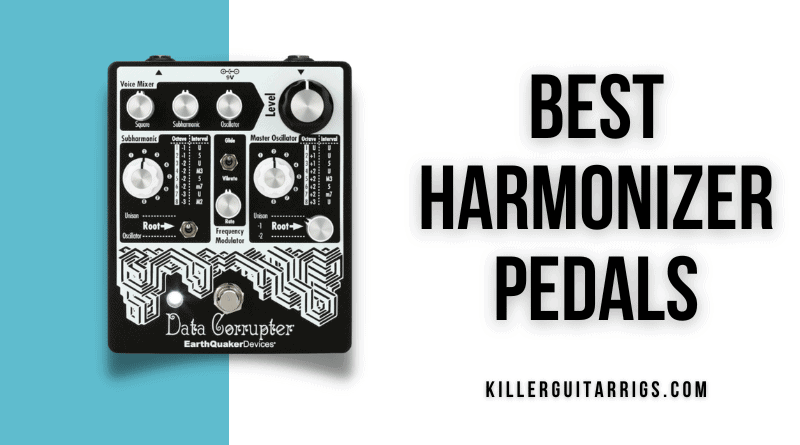A harmonizer pedal can give you a unique flavor for melody lines and solos. Although sometimes used for harmonizing chords or even getting weird and experimental, harmonizer pedals tend to be mostly employed for single lines.
As their name indicates, these pedals create a harmony above or below the note you play on a guitar. You pick the interval of said harmony and decide whether it should go up or down. An interval is simply the distance between two notes, and one of the building blocks of music. Different intervals give you different sounds which can differ greatly from one another.
There are different types of harmonizer pedals in the market. Some are simpler and offer basic harmonies to choose from and others are more complex and even feature added effects, extensive I/O, different modes of operation, and more. In this article, we’re going to help you decide which model is best for you. Keep reading.
Read more about our review process.
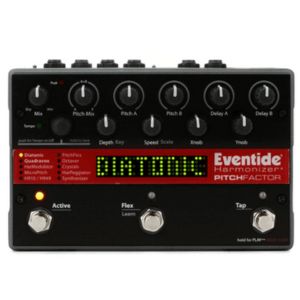
Eventide PitchFactor Harmonizer
Features: Cast metal construction, Mono/Stereo I/O, 4 Voices of diatonic pitch shifting
Benefits: Studio quality tones, Can be upgraded by USB, Almost limitless tonal options
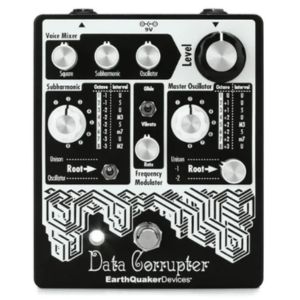
EarthQuaker Devices Data Corrupter
Features: Modulated monophonic PLL circuit, Glide mode, Subharmonic generator
Benefits: Plays up to 3 octaves +/- input, Fantastic textures, Easy interval selection
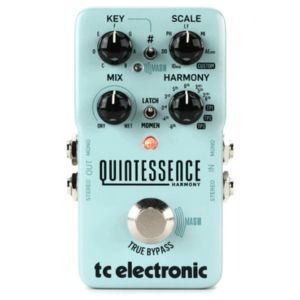
TC Electronic Quintessence
Features: MASH footswitch, Two-voice harmony FX, Momentary/latching switch
Benefits: Super compact footprint, Highly expressive, Low noise performance
Contents
Our Top 3
The EarthQuaker Devices Data Corrupter is our Top Choice. This is a three-voice harmonizer that can handle all of your harmonization needs and also take you into experimental territory quickly. From basic intervals up to three octaves down and up all the way to fuzz-like and synth-like tones, this pedal delivers the goods.
The TC Electronic Quintessence Harmony is our Budget Choice. This pedal features just four knobs and Latch and Momentary modes of operation. It features a simple design while offering comprehensive harmonization options at an affordable price.
The Eventide PitchFactor is our Editor’s Choice. This pedal is a great option for discerning guitarists that require the best. A robust harmonizer that includes the best pitch and delay effects from Eventide’s rack units, the PitchFactor comes with 100 factory presets and a vast amount of features.
Individual Reviews
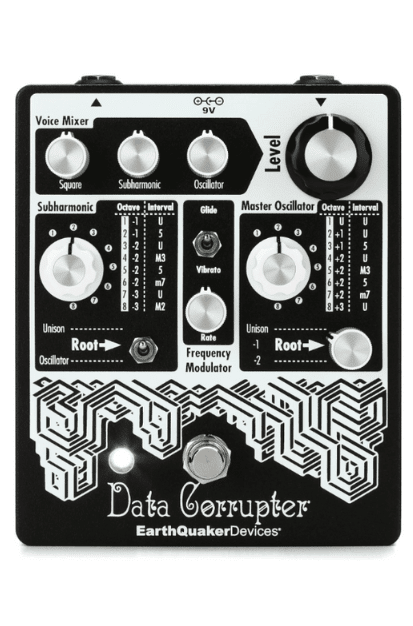
EarthQuaker Devices Data Corrupter
A harmonizer that can widely transform your tone.
EarthQuaker Devices is known to provide truly unique effect pedals, and the Data Corrupter is an excellent example of that. This well-built unit can convincingly harmonize your main note up or down, but it goes well beyond that. You can take your tone to unsuspecting territory for a uniquely different sound whenever necessary.
The EarthQuaker Devices Data Corrupter is a three-voice harmonizer that features a modulated monophonic phase-locked loop circuit and three main voices to operate from.
With our Strat and Fender Twin amp, we dived into the top three knobs which control the three individual voices, with Square, Subharmonic and Oscillator. The master oscillator gave us well-defined harmonies across three octaves above the note we played. Our favorite use was playing in fifths, done by selecting position three.
We turned the Square Wave up on the voice mixer for a voracious and very aggressive fuzz tone that can function in metal contexts or for those guitarist who like to get quite experimental with their tone.
The Subharmonic section of the Data Corrupter looks almost identical to the Master Oscillator section. Here, we also got well-defined intervals to harmonize our main note, but this time it was below the fundamental or start tone. Although we went all the way down to three full octaves, our favorite sound was down a fifth.
Right between the Subharmonic and Master Oscillator section, we found a switch for choosing between Glide mode and vibrato. While in Glide mode, we got synth-like portamento effects. On the other hand, Vibrato mode gave us a bit of frequency modulation that made some of our single notes and musical passages have a unique expression.
Besides giving us an effective harmonizer with major thirds, seconds, fifths, and minor sevenths, this analog pedal can go into experimental territory fast. This is easily done in the Voice Mixer section above, where we controlled the Square, Subharmonic, and Oscillator voices.
With true bypass operation, this harmonizer pedal is a fantastic option for adding girth to your lines as well as going into uncharted sonic territory. Well-built and cleverly designed, it is one of the best options out there for musicians that are not afraid to go beyond and try something new.
Verdict: The EarthQuaker Devices Data Corrupter is a harmonizer that features your basic intervals up to three octaves down and up the main fundamental note. Besides, you get fuzz-like and synth-like tones for maximum experimentation at any given moment.
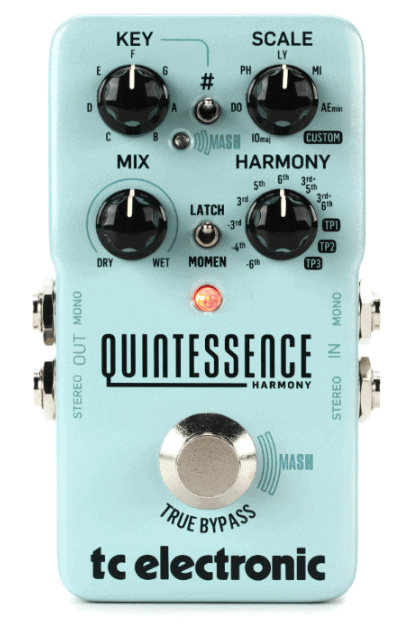
EarthQuaker Devices Data Corrupter
Ingenious design on an effective harmonizer.
TC Electronic has become one of the go-to pedal companies for modern guitarists of every style. They have a consistently high-quality level with each of their pedals, and this harmonizer is further proof of that. Besides being easy to use, it is also quite affordable.
The TC Electronic Quintessence Harmony pedal is a unique harmonizer that features four knobs and two modes of operation: Latch and Momentary. The first thing we liked about this pedal is how simple its design is, while at the same time offering comprehensive harmonization options.
We started our tests by setting the upper left knob to the key of C. This knob allows you to choose which key you want to use. Right next to it there is a switch that adds a sharp to the key when placed in the upward position, while the low position keeps the key natural. In other words, if we wanted to play in C#, we’d have to move the switch up.
To make it interesting, we then went to the next knob on the right, which sets which mode of the major scale is in use. You get the first six modes: Ionian (regular major scale), Dorian, Phrygian, Lydian, Mixolidian, Aeolian (regular minor scale), and a position for custom scales. You can use the TonePrint app to create your own custom scale for further tonal control.
We first choose the Phrygian scale, which is a minor scale with a minor second as the first interval. With several interval choices available, including thirds, fifths, and sixths, we got plenty of options to harmonize our fundamental notes. We also loved the pressure-sensitive MASH footswitch on this pedal. We were able to bend harmonized notes up or down to the next interval by simply keeping the footswitch pressed longer.
The addition of a Dry/Wet knob was a great idea by TC Electronic, as it allowed us to dial in just how much of the effect we wanted. In short, a nice harmonizer that comes with great build quality and delivers much more than its low price suggests.
Verdict: The TC Electronic Quintessence Harmony pedal is a fine harmonizer that features Latch and Momentary modes of operation and comes with the company’s TonePrint app for detailed settings. With a simple design and complete harmonization options, this pedal is a well-built and affordable option for guitarists of different styles.
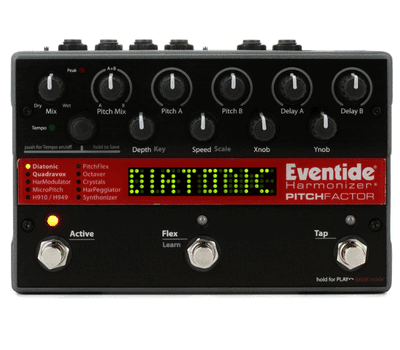
Eventide PitchFactor
A complete harmonizer with a vast array of features.
Eventide is usually associated with names like Eddie Van Halen and Steve Vai, as both guitarists used this company's effects to obtain some of their signature sounds. It comes as no surprise that the PitchFactor harmonizer is a great option for detail-oriented folks that want to get the most out of their gear.
The Eventide PitchFactor is a robust harmonizer pedal that features some of the best pitch and delay effects from Eventide’s rack units. This unit can give you up to four voices of diatonic pitch shifting, effectively allowing you to build a chord from a single note. We dived right in by auditioning the 100 factory presets that come with this harmonizer.
The presets go from traditional to wild, and once we found a few that we liked, we were able to adjust them using the knobs above the screen in order to tweak it to our liking. We would then save the adjusted preset to an assigned bank, in order to easily retrieve it later.
It is important to note that to get the most out of the PitchFactor, we hooked our Boss EV-30 expression pedal. All presets come with expression pedal assignments, so it was easy for us to just plug in our pedal and play.
Overall, the effects and sounds on the PitchFactor are excellent. Our favorite modes were Diatonic for simply and accurately harmonizing single notes and Octaver, for adding serious girth to a solo or line.
We also liked how easy it was to add and control the delay levels on this pedal. With dedicated knobs labeled Delay A and Delay B, it was easy to adjust them or remove them completely at will.
In short, this pedal offers a complete solution for harmonizing your parts and then some. To make the most out of it, there will be a learning curve that involves reading the manual carefully. However, once you spend some quality time with this unit, you’ll be hard-pressed to find a more complete and superior harmonizer.
Verdict: The Eventide PitchFactor is a powerful harmonizer pedal with fantastic sound quality. It comes with some of Eventide’s best pitch and delay effects, which are easily controllable. With true analog bypass, tons of features and 100 factory presets, this unit is a great choice for dedicated guitarists that are not afraid of reading a manual.
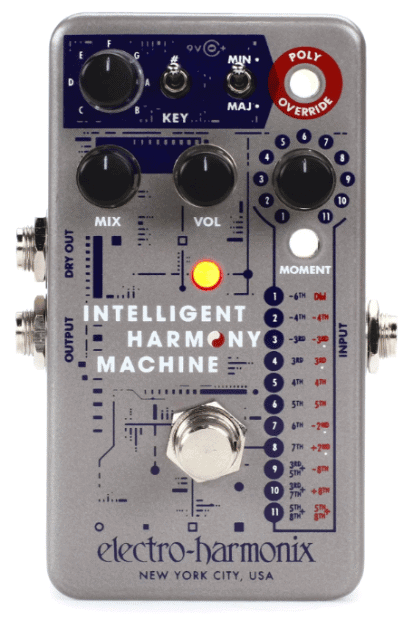
Electro-Harmonix Intelligent Harmony Machine
A complete harmonizer with a smart design and operation.
Electro-Harmonix has been in the pedal game for a long time and is among the most respected companies in the industry. This harmonizer comes with all the quality, sturdiness, and overall level of functionality that we've come to associate with this reputable brand.
The Electro-Harmonix Intelligent Harmony Machine is a harmonizer pedal that doubles as a polyphonic pitch-shifter pedal. It offers two operating modes, labeled Intelligent Harmony Mode and Polyphonic Override Mode.
We started our tests by using our Strat and Fender Twin Reverb amp and setting this pedal to Intelligent Harmony Mode. Here we got basic harmonizer functioning with diatonically accurate harmonies depending on the chosen key. In true EHX mode, we got great quality with very smooth tracking for melody lines. Not only were the harmonies above and below well defined on single note runs, but also on simple chords as well.
Although it may look a bit intimidating, we were able to easily and quickly dial in the type of harmonies we wanted via the key selector and the top left of the unit. This selector features all 12 keys and has a switch for making the key sharp and another for picking either major or minor scale.
The 11-interval selector switch offers plenty of harmonizing choices.
Moving on to Polyphonic Override Mode, we got a pitch-shifting type of operation that reminded us of the Electro-Harmonix classic Pitch Fork pedal.
Both modes of operation offer 11 harmonization/pitch options to choose from. Another feature that we loved about the Intelligent Harmony Machine was the ability to use it in Momentary Mode. Here we were able to shift the pitch by an interval of our choosing by simply stepping on the footswitch. Also, in this mode, the volume knob dictated the sweep time between our dry signal and the effect, which allowed us to fine tune our sound even further.
In short, a complete harmonizer that can double as a pitch shifter and offers fantastic tracking and overall quality. With a hard and rugged enclosure, this pedal is built like a tank, and will likely last you a lifetime.
Verdict: The Electro-Harmonix Intelligent Harmony Machine is a harmonizer pedal that can also be used as a polyphonic pitch-shifter unit. With fantastic accuracy and smooth tracking, this harmonizer offers a complete solution to folks that need a reliable way to harmonize their single notes as well as chords.
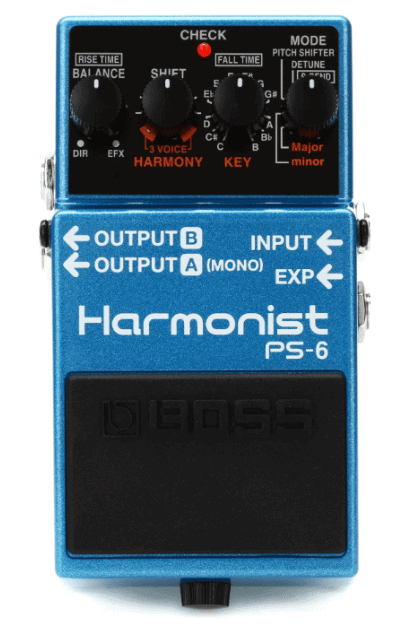
Boss PS-6 Harmonist Pedal
A harmonizer with traditional Boss construction.
For many, Boss is the undisputed stompbox company. With decades of offering a staggering amount of pedal models, this company delivers the goods. The PS-6 is a simple but effective harmony pedal that comes in the traditional Boss stompbox form factor.
The Boss PS-6 Harmonist is a versatile pedal that offers multi-voice harmonization, pitch shifting, chorus (via the detune option), and octave shifting. The first thing we liked about it was its simple four-control top panel operation, where all the tweaking is done.
We started by setting the rotary Key knob to F and choosing major as the corresponding scale on the mode selection knob on the right side of the pedal. This gave us straightforward harmonization that was appropriate for single lines.
We particularly liked the result we got when the pedal was set to fifths, octaves, and fourths. However, the thirds and sixths were not as clear and sometimes came with undesirable digital artifacts.
We then went on to the S-Bend mode, while using the Rise Time and Fall Time knobs to define how long it takes for the note to reach its pitch. By pressing the footswitch, we shifted the pitch of the notes, and by releasing it we could make the note either climb or drop to the actual notes we were playing.
All things considered, the PS-6 Harmonist allowed us to quickly create two- and three-voice harmonies that can be useful in a variety of contexts. Naturally, the selectable key and voicing options were also quite useful. Additionally, we also liked the ability to control pitch via an expression pedal that this pedal offers.
In short, a good harmonizer is built in the typical Boss form factor. However, if you are a purist that requires pristine quality and results for all interval options, you may want to check out other harmonizer options.
Verdict: The Boss PS-6 Harmonist is a versatile harmonizer pedal that offers straightforward and pitch-correct harmonization, as well as pitch shifting and other options. It comes in the beloved Boss stompbox form factor and offers useful features like Detune, Expression Pedal in, Super Bend Mode and more.
How to Choose the Right Pedal for You
A harmonizer pedal works by imitating your original input signal and playing it back to a different pitch along with the original signal. This creates harmony. Without wanting to get too technical and at the risk of oversimplifying, harmony is defined as two or more notes sounding at the same time.
Harmonizer pedals give you the option to either lower or raise the pitch of the sound by an interval that you specify. You can also choose it to be an octave up or octave down, and in some cases even go beyond that.
This gives the guitarist a massive amount of options to embellish single lines, solos, melodies, and sometimes even chords. Below we give you a few pointers and things to consider before deciding which harmonizer pedal is right for you.
Tuning and Intonation
Because harmonizer pedals work based on their response to the note that you play, it is crucial to keep your instrument well-maintained. Besides being tuned well, intonation also becomes a central issue with harmonizers.
For instance, if your intonation is off, you may get good results around the fifth fret and poor harmonization beyond the 12th fret. Needless to say, poor intonation has the power to ruin your solo or line, as you’d have two (or more) notes out of tune that will make your audience cringe. So make sure your instrument is in tip-top shape before going out and buying a harmonizer. If necessary, bring it to a professional for evaluation.
Do I Need to Know Music Theory?
Harmonizer pedals give you detailed choices for which intervals to pick and which key as well. Some even go as far as featuring knobs for picking one of the seven modes of the major scale. Others will give you a choice of picking either a major or minor scale.
Through the use of included software, some harmonizer pedals give even more scale options like harmonic minor, diminished, altered, whole-tone, etc. With so many possible scenarios, the question begs to be asked: do you need to know music theory? And if so, how much?
The best answer to this question is: no, but it would certainly help. That said, learning music theory will make you a much stronger and more knowledgeable musician, able to make wiser choices at all times. And operating a harmonizer pedal is just one of many many times this knowledge will be useful.
Where to Place Your Harmonizer in Your Signal Chain
Choosing the right place for your harmonizer pedal is vital to ensure quality and proper function. Different positions can cause different results, some of which are not at all desirable.
In general terms, harmonizer pedals should follow the basic effect type order for pedal boards. Typically the beginning of the chain is reserved for dynamic effects, filters, pitch shifters, and volume pedals.
You then move on to overdrive or distortion units, which are then followed by time-based effects like reverbs and delays, reverbs. This particular way of setting up your pedal board is one of the most popular and tends to yield the best results, although there are always some exceptions.
Harmonizer pedals function by shifting your pitch and therefore should go on the pitch-shifter section, which is placed toward the beginning of your signal chain. Many experts say that the harmonizer should be placed right after the compression pedal for accuracy.
The rationale is that harmonizer pedals will have better chances to generate cleaner results when placed closer to the original source. In our case, the guitar.
The principle of intonation and tuning also applies here. You want the note that goes into the harmonizer to be as precise as possible, in order to ensure proper functioning. If you place your harmonizer after distortion, fuzz, or overdrives, the fundamental note becomes too complex for the harmonizer engine to properly detect.
Simple vs Complex
Like most things guitar related, the level of simplicity from any piece of gear is to be determined by you. As with many other instances, you should ask yourself what you need the harmonizer for.
If you want to simply harmonize in common intervals like thirds or fifths, then a simple solution will likely do the trick. On the other hand, if you’d like to get deep into harmonization possibilities, create your own custom scales for harmonizations and such, a powerful unit is a must.
The same is true for folks who want to have the best of both worlds. If you want to be able to harmonize single lines, but also go into widely experimental territory, get a pedal that can give you that ability. For instance, the Data Corrupter by Earthquaker Devices can do both things really well.
Price
Price is another important consideration and is closely tied to how good and complete the harmonizer is. The best ones will naturally cost more and the same is true for those that offer other effects, plenty of features, and other attributes.
Again, knowing what you want and need is imperative. Take the time to check out some of these pedals, preferably in person. This will help you arrive at an informed decision. After all, you want to be using your harmonizer for a long while and getting the most out of it.
Final Thoughts
Harmonizer pedals can add quite a bit of flavor to your playing. They offer a particular sound that many of us associate with the guitar work in bands like Iron Maiden, Thin Lizzy, and even The Eagles toward the end of the classic Hotel California solo.
Besides allowing the user to harmonize single lines and chords by choosing the interval, direction, scale and other options, harmonizer pedals can also get weird. If you want to engage in some tonal experimentation, there are some harmonizer pedal models that will give you a run for your money.
However, if you want to just keep it simple and carry out regular harmonies to embellish your single lines or even chords, stick with a more straightforward option. Whatever your situation, there’s a harmonizer pedal out there appropriate for you.
To quickly recap our options, the EarthQuaker Devices Data Corrupter is our Top Choice. This is a three-voice harmonizer that can take care of your harmonization requirements and also bring you into experimental territory fast. From essential intervals up to three octaves down and up all the way to fuzz and synth tones, this unit has got you covered.
The TC Electronic Quintessence Harmony is our Budget Choice. This pedal comes with just four knobs and offers you Latch and Momentary modes of operation. With a simple design and complete harmonization possibilities, you get a great pedal at an affordable price.
Finally, the Eventide PitchFactor is our Editor’s Choice. This pedal is an excellent choice for discerning guitarists that demand the best. A powerful harmonizer that incorporates the best pitch and delay effects from Eventide’s rack units, the PitchFactor is loaded with 100 great-sounding factory presets and an extensive collection of features.

